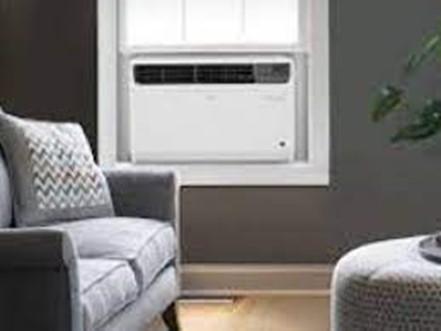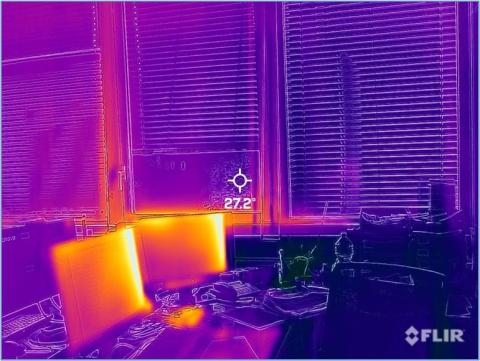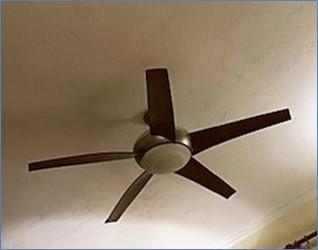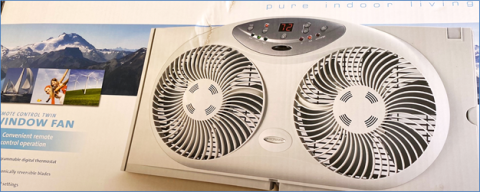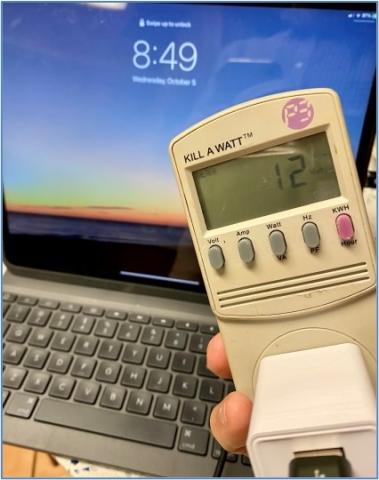Scope
To minimize health and comfort effects related to extreme heat events, create a “cool room” or space within the home to shelter from extreme heat.
- Select a room that can be closed off from the rest of the home, has minimal heat gain through windows, walls, or ceilings, and is large enough to shelter the home’s occupants during a heat wave.
- Use shading, low solar heat gain coefficient windows, and other solar control techniques to reduce solar heat gain to the room.
- Use insulation and air sealing to minimize heat gain through the walls and ceilings.
- Limit electrical loads and other internal sources of heat within the space.
- Provide a dedicated emergency cooling source.
- Provide emergency refrigeration (located outside the room) for food and medications.
- Provide backup power sufficient to serve emergency cooling and refrigeration loads.
See the Compliance Tab for links to related codes and standards and voluntary federal energy-efficiency program requirements.
Description
Given the reality of global climate change and the increasing likelihood of extreme heat events, designing and retrofitting homes for resistance to extreme heat and power outages should be considered in all climates. Extending the "hours of safety" that a home can provide when air-conditioning is not available can be life-saving. However, it is not necessary for an entire home to be resistant to extreme heat. Instead, the design or retrofit can concentrate on just one room. When full-home-scale measures with backup power are cost-prohibitive, impractical, or not appropriate for the climate, a cool room can be a cost-effective and sensible approach.
A cool room is a designated area in a home or dwelling that is designed to provide protection for occupants during extreme heat events. The room should intrinsically resist overheating while providing a relatively comfortable place to take refuge during the day and/or to sleep at night. It should have low enough heat gains that it can be cooled by a small emergency cooling system (Figure 1). Ideally the room will be served by a backup power system sufficient to power the emergency cooling system and any vital refrigeration equipment. Cool rooms can be included in new construction or created in existing homes as a retrofit.
It is important to consider what situations are most appropriate for the creation of a cool room. For instance, a new home built to recent building energy codes, with reliable central A/C, photovoltaic panels (solar panels), and a whole-home battery backup system would likely not need a specific cool room. On the other hand, for an older home that doesn’t have a lot of insulation and doesn’t have central A/C, establishing a designated cool room could be critical to survival in an extreme heat event. In this case, installing a small, dedicated A/C unit for a single, well-designed room would be a cost-effective approach to mitigating health risk during heat waves as well as improving general comfort during the summer.
Homes without air-conditioning are likely candidates for a cool room. Many of these homes are located in regions with typically cooler summers where air conditioning is usually not needed. Climate predictions show extreme heat events increasing in northern climates more than in southern climates; for these areas, the “cool just one room” concept could well be appropriate. Further, an emergency cooling system can serve double duty if a heat pump is used rather than just a basic air conditioner. This would allow the unit to be able to provide efficient supplemental heating in winter as well as cooling in summer, likely providing cost savings as well as providing backup if the central heating system fails. A cool room could become a “warm room” during extreme winter events, taking advantage of the extra insulation and air sealing used to separate the cool room from the outside and the rest of the home.
Cool rooms also make sense for homes that don’t have full-home backup power. During a power outage (which is more likely during extreme heat), the small electric loads needed to cool a single room could be handled by small-scale or portable backup power. Even with no backup power at all, a room designed to stay naturally cooler would be a great asset in such a situation.
Where to Locate the Cool Room
Determining where the cool room will be located within a residence is a key consideration. In general, the room should be located on the north or northeast side of the home. It is best to avoid unshaded south, east, or west sides of the home due to solar heat gain unless these areas are very well shaded on the exterior by porches, overhangs, or exterior landscaping. South-facing walls are much easier to shade effectively than east- or west-facing walls due to how low in the sky the sun can be when shining from the east and west. Figure 2 shows a picture of a southeast-facing wall, along with a thermal (infra-red) image of the same wall. In the thermal image, lighter colors represent higher temperatures. The white-yellow of the unshaded wall indicates that this is not a good location for a cool room.
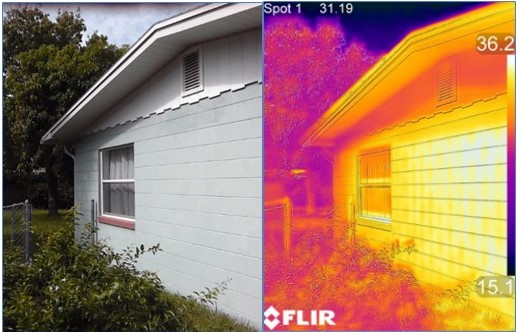
Different orientations will become hotter during different parts of the day. In general, east-facing exposures will be the hottest areas from morning to midday, while west-facing exposures will be the hottest from early afternoon through evening. Because outdoor temperatures are usually hottest in the late afternoon, rooms with west-facing walls are generally the most vulnerable to overheating. If the emphasis is on interior comfort during evening hours, then rooms with an unshaded west exposure should be avoided (Rilatupa 2019).
Windowless basements will usually stay naturally cooler than any other location in a home. Any room that is completely interior will similarly avoid heat gains through windows and walls. However, these spaces may not be ideal for selection as a cool room. It may be difficult to effectively ventilate the space during evening hours when outdoor temperatures may be cooler, and access to natural light will be limited. These spaces may be unpleasant for long-term refuge.
However, if a means of ventilating and cooling can be provided, windowless interior rooms or especially a basement room may be the home’s best option. Cooling might be provided by a ducted portable A/C unit, mini split heat pump, or even a window fan to the outside in an adjacent room. In the case of a power outage with no backup, such a space may be the coolest location during the day, but may be one of the warmer areas at night. Under this situation, a useful strategy would be to open all perimeter windows at night and open the interior cool room to the perimeter rooms. Then close the cool room down during the day. During the day this space’s temperature would peak lower than the rooms with windows and other exposure to the outside. If perimeter rooms with windows are cooler at night than the interior room, occupants could choose to sleep there.
Protecting the Cool Room from External Heat Gain through Windows and Walls
Window area, orientation, and shading are critical to how hot a room can become without air conditioning (Barnaby and Wilcox 2007). Any windows in the cool room should have exterior and/or interior window treatments for shading. In general, exterior shading will be more effective at reducing heat gain than interior treatments. During the day, blinds, shades, or curtains should be deployed for any exposed windows. Customized interior shades that seal to the perimeter of the window can be more effective than loose-fitting or freely hanging shades. Regardless of shading type, a white or light color on the exterior side of the shade will generally be most effective at reflecting sunlight back out the window (if sunlight is absorbed by the shades rather than reflected, it turns into heat). There are many options for exterior shading systems, including roller shades, permanent or movable shutters, awnings, solar screens, pergolas, porch roofs, overhangs, shade plants, and trees. See the Energy Efficient Window Coverings webpage by DOE for more information on window attachment systems. Horizontal overhangs are a good option for protecting south-facing windows. East- and west-facing windows receive very low-angle sunlight and should be well-shaded by landscaping, awnings, solar screens, or shutters like the Bahama shutters shown in Figure 3. See the guides “Shading and Solar Control for Windows and Skylights" and "Window Attachments for Solar Control and Energy Efficiency” for more information.
For new construction or window upgrades, specify that the new windows have a low solar heat gain coefficient (SHGC). Using ENERGY STAR-labeled windows designed for your climate is a reliable way to ensure the SHGC of the windows is appropriate for your area. See the “High Performance (ENERGY STAR) Windows” guide for more information on SHGC requirements for different areas of the country. If a window upgrade is not planned for an existing home, consider adding insulating storm windows with a low-emissivity coating, which will keep out unwanted heat gain while improving the overall insulation value of the windows. See the guide “Low-E Exterior Storm Windows” for more information.
Landscaping is one of the most effective ways to provide shading and localized cooling. Figure 4 below shows the effect of a shade tree on a hot day. Side-by-side visible and infra-red images show a significant temperature difference between where there is shade and where there is no shade. See the “Landscaping to Reduce Cooling Load” guide for in-depth information on using landscaping to aid cooling.

The exterior walls of the cool room should be well-insulated, especially if they will be exposed to direct sunlight. If new construction, walls should be insulated at least up to local code, and preferably to insulation levels specified in the 2021 International Energy Conservation Code (IECC) or higher. Light-colored exterior walls are best to reduce absorption of solar heat. Window area should be limited, ideally to no greater than 35 square feet in the cool room. It will likely be desirable to have at least one single- or double-hung operable window to accommodate window fans or air conditioners, to provide ventilation, and to provide natural diffuse light.
If the house is multi-story, a first story or basement location is preferred to avoid heat gain through the ceiling. If the home is one-story with no basement, or the cool room must be located on the top level of the home, a cool roof, radiant barrier system, and/or high levels of attic insulation are suggested (Figure 5). See the “Cool Roofs and Walls to Reduce Heat Gain”, “Attic Radiant Barriers”, and “Air Sealing, Insulating, and Venting Attics and Roofs to Reduce Heat Gain” guides for more information.
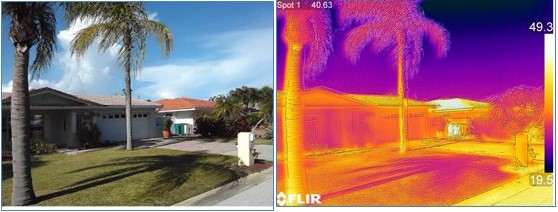
Avoiding Internal Waste Heat from Appliances and Electronics
The designated cool room should not contain large appliances such as refrigerators, dryers, or ranges that generate a lot of excess interior heat. Even medium-sized and small electronics can release considerable heat (Figure 6). While many people will consider the importance of shade or insulation, occupants can forget that internally released heat can have large negative impacts when trying to keep a space cool.
Improving cool room performance can be as simple as using cooler, energy-efficient lighting or turning off a second, unused computer. Some equipment, such as mini refrigerators, are desirable to have nearby for convenience. These should not be located inside the cool room, but can instead be located in a room nearby. Incandescent and halogen lighting should be avoided. Lighting should be of an efficient type such as LED fixtures, or diffuse natural light, to reduce heat gain.
Actions and Habits to Help Stay Cool
The success of a cool room during an extreme heat event depends largely on occupant behavior. Below are some basic concepts occupants can implement to help stay cooler during a heat wave:
- Avoid cooking food as much as possible.
- If cooking, cook at night, and consider cooking outside on a grill to keep the heat out of the house altogether.
- Turn off unused appliances and computers.
- Eliminate incandescent lighting.
- Close blinds on sunlit and exposed windows that can later be opened during cooler nighttime hours.
- Drink cool beverages that have been refrigerated outside the cool room.
- Wear lightweight clothing.
- Limit physical activity.
Additional Considerations for a Cool Room
The usefulness of the cool room may be improved if there is an attached bathroom with a quiet, efficient exhaust fan. The room or rooms should include furniture to accommodate multiple occupants. Portable cots or hammocks may be desirable for sleeping or resting, as these are cooler than a standard mattress. They also may be useful to preserve space in the cool room since they can be moved or folded away. Air mattresses provide similar benefits.
The power consumption of each item in the cool room should be analyzed for three important reasons: 1) the power used will heat the space, 2) the power used will drain the battery backup power or use up generator fuel, and 3) higher equipment power will require a larger, more expensive battery or generator backup power system. In a disaster situation, energy efficiency serves multiple purposes beyond reducing pollution.
Cooling Systems for Cool Rooms
The BASC guide “Emergency Air-Conditioning and Food Refrigeration” details various options for one-room cooling and backup power systems. It is recommended to reference this guide when considering a cooling system and backup power for a cool room.
Plug-in or Hard-Wired Fans
Although fans will not lower the air temperature in the room, they do provide legitimate cooling to a person’s body. Fans lose effectiveness as conditions get hotter, however, and above about 95°F to 105°F, fans are no longer beneficial (Steadman 1979 and Morris et al. 2021). Fans are low power users, offering one of the most efficient ways to provide cooling while saving generator fuel, battery charge, or grid energy. Consider installing an efficient ceiling fan to help with personal cooling even if there is whole house backup power and conservation is not a priority (Figure 7). The fan should be shut off when the room is unoccupied as the motor will add heat to the space.
A small, reversible window fan is another low-power option (Figure 8). These fans can be set to draw air out of the home during the day, to draw in outside air at night if outdoor temperatures drop below indoor temperatures, or to operate both ways simultaneously to exchange indoor and outdoor air to provide ventilation (Figure 9). Typically, they are set to drawn in outdoor air at night when outdoor conditions are cooler.
The power usage of such fans is quite low: about 40 Watts on low speed, 50 Watts on medium speed, and 65 Watts on high speed. This means a small battery backup system could provide these fans with hours of operation.
Portable, floor-mounted or desktop plug-in fans are also a viable low-energy option, but they will be less effective at bringing in outdoor air. These fans should be set up to blow air directly across occupants’ skin. Otherwise, their usefulness is limited, and they will only add heat to the room (from the motor when operating). Using fans for various low-energy cooling strategies is discussed in the “Passive and Low-Energy Cooling” guide.
Battery-Powered Fans
If the cool room has no backup power in the form of a generator or battery bank, stand-alone battery-powered cooling is an option. There are rechargeable battery-powered ceiling fans that can charge from a USB cable and can run overnight without recharging (Figure 10). Solar-powered chargers and USB battery power banks can be used in the day to provide nearly continuous operation.
One or two small battery-powered portable circulation fans can also be set up in the room. These can be charged from a USB port and are rechargeable while operating. A battery charge can generally last 8 to 25 hours depending on selected fan speed. There are types that have integral lights as well as power receptacles to operate smart phones or other small devices. Some have hooks for a hanging installation, while others have adjustable tripods (Figure 11). Some have large batteries (20,000 mAh) and are capable of operating for up to two days between chargings. For all these small devices, recharging will require a power supply. Ideally the power supply can be recharged by the sun during daytime hours. Small battery banks with portable solar panels are available that would serve this purpose well.
Evaporative Coolers
If the cool room is located in a dry climate such as southern California, Arizona, or New Mexico, then evaporative cooling may be an option. Small, portable, battery-powered evaporative coolers can be utilized for personal cooling (Figure 12). Many of these units are very small and have limited cooling capacity. They can provide effective cooling when directed toward an occupant, but may have a minor impact if trying to cool the room in general. The advantage is that they have very low power use. Many models draw only 7 to 15 watts when operating. These can provide evaporative cooling for up to four hours without adding water or recharging the battery.
Plug-in portable or window-mounted evaporative coolers are also an option. These units can provide far more cooling than small battery-powered units, with numerous products available ranging in capacity adequate for an area of about 100 ft2 to 2,000 ft2 (or more). The power draw of these units is generally in the range of 50 W to 500 W depending on capacity. Evaporative coolers require air exchange with the outside. It is recommended to open a window slightly or use a bathroom exhaust fan or other means of exchanging moist indoor air with dry outside air.
Mechanical Air Conditioning
In non-arid locations, standard air conditioning or heat pumps must be considered. These systems provide dehumidification when cooling. The types of air conditioning systems appropriate for a cool room are available as A/C-only or as heat pump models. A heat pump is nearly identical to an air conditioner, but has the ability to provide heating as well as cooling. A cool room that has a heat pump for cooling could also heat the room in winter. This may appeal to those who want to reduce heating energy and/or to create a “warm room” that can be kept at a cozy temperature while leaving the rest of the home cooler in winter. High-efficiency heat pumps (such as mini-splits) are ideal for use during milder winter temperatures to reduce the energy use of a less efficient central system. They also provide a form of backup heating should the main heating system fail.
Air-conditioning and heat pump systems include portable units, window units, and mini-split heat pump systems. In any case, unless the house has a large solar PV system with a large battery bank, or a large whole-home generator with ample fuel, it is important that a small, efficient cooling system be selected to cool the space. This will enable a standard generator to provide power for cooling while conserving fuel, or a modestly sized battery bank (1 to 4 kWh) supplemented by a small PV array for charging to provide effective cooling during daytime hours.
Portable A/C systems are less efficient than window A/C units or mini-split heat pumps. They are awkward in application as flexible ducts must be connected from the unit to the outside so heat can be rejected out of windows. The homeowner or installer should plan for a means to provide some insulating and air sealing of the area where the portable unit’s intake and exhaust ducting go through a window opening. If the cool room is located in an interior windowless area, a portable A/C unit should have its exhaust/intake ducts routed to the outside by the most direct route.
Window A/C units and mini-split heat pumps are recommended as dedicated small cooling systems for a cool room. A small window air conditioner (Figure 13) or heat pump installed in the space would typically be about 5,000 – 6,000 Btu/hr in size. A mini-split heat pump system may be a little larger (9,000 Btu/hr) depending on the smallest size offered by the manufacturer. Mini-split systems are typically much more efficient than standard window unit air conditioners.
Window unit air conditioners typically have an energy efficiency ratio (EER) of about 10 Btu/Wh whereas mini-split air conditioners or heat pumps typically have cooling EERs of about 17 Btu/Wh, thus providing much more cooling for the energy used. Furthermore, a mini-split heat pump may be used during other times of the year for both heating and cooling, likely being more efficient than the central system in the home. A mini-split heat pump unit is likely to be quieter inside the house as well, which can be important for getting good sleep. See the “Emergency Air-Conditioning and Food Refrigeration” and “Ductless (Mini-Split) Heat Pumps” guides for more information on these types of cooling systems.
A combination of mechanical air conditioning and fans (window, ceiling, or portable) can be used in a cool room. Fans use only a fraction of the power of an air conditioning system, so if you have limited backup power (or are low on power available from the battery bank, or are low on fuel for a generator), fans can be used. Ceiling fans or portable fans can be used at the same time as air conditioning to increase its effect.
Other Cooling Approaches
In addition to fans, evaporative cooling, and mechanical air conditioning, passive and low-energy cooling methods can be used. If the home has a heat pump water heater, it can provide a free source of cooling and dehumidification. Ducting the cool air from the heat pump water heater into the designated cool room may be an option for additional cooling of the space. Locating the heat pump water heater directly in the room would work as well, but the noise of the unit could make sleep difficult.
Another temporary option worth mentioning is using ice directly for cooling. When power goes out, ice may be taken from an icemaker or freezer outside the cool room and put in a bucket inside the cool room. Consider blowing air across the bucket with a fan. This will cool and dehumidify the air. There are commercial products available that use this concept. Note, however, that consuming the ice directly (as ice water, for example) will provide much more efficient body cooling than using one of these devices. Unless ice is particularly plentiful, consuming ice or applying it strategically to the body directly (an ice pack on the back or neck, for example) are recommended over cooling the air with an ice bucket or other device.
Heat pump water heaters, various types of fans, wind, and other passive and low energy options can be explored in the “Passive and Low-Energy Cooling” guide.
Air Sealing and Air Purification during Wildfires
If the home is located in an area prone to wildfire, the doors and windows in the room should seal very well as it can become important to seal the space against pollution. For new construction, a room blower door test may be used to help guide effective sealing for the space in the event of wildfire smoke.
A small air cleaner may be considered if smoke during extreme heat events is a chronic regional problem. Look for air cleaners that filter air down to 0.3 microns. Such air cleaners typically use 40 to 70 Watts when operating. Searching for air cleaners using the U.S. EPA’s EnergyStar product database is strongly recommended.
Prioritizing Loads on Backup Power
As the backup power source may be limited, it is important to prioritize the electric loads it serves. For example, if one has a small whole-house battery system, it may be good to leave the home’s central cooling system off, and instead give priority to the small cooling system for the cool room along with a refrigerator and a charging outlet.
Portable battery systems usually have relatively low energy storage, so only small, vital loads should be connected. Whole-house battery systems with photovoltaics have much greater storage capacity and are readily recharged. It is important to know exactly how much back up power is available and how much of that power is consumed by various loads. Measuring loads with a portable power measuring device can help determine the impact of different appliances (Figure 14).
How to Create a Cool Room
Cool rooms can be designed as part of a new construction project or retrofitted into an existing home. Key features to include in a cool room are provided in Figure 15.
Locating the cool room:
- If the house is more than one story, a first story or basement location is preferred to limit ceiling heat gain.
- Locate the room on the north or northeast side of the home, preferably with exterior landscape shading, to minimize solar-related heat gain. If on other exposures, then these areas are best to be shaded on the exterior by porches, overhangs, awnings, shutters or exterior landscaping. Basements, particularly daylight or walk out types with a single shaded exposure to the outdoors, may be ideal.
- Choose a location with minimal exterior wall area. One exterior wall is better than a corner room with two exterior walls.
Designing the cool room:
- Ensure the room can be shut off from the rest of the house.
- Ensure the room is large enough to house the occupants comfortably, but small enough to limit retrofit costs and keep cooling systems small and power draw on a backup power system within its limits.
- Provide for comfortable sleeping via beds (warmest), blow-up mattresses (cooler), cots (cooler still), or hammocks (coolest).
- Insulate exterior walls at least to local code levels or 2021 IECC, whichever is higher.
- Interior walls enclosing the room should be insulated - the standard acoustic insulation should suffice for thermal control.
- Choose light-colored exterior walls to provide solar control.
- Minimize windows to no greater than 35 square feet in the cool room and include at least one operable window for installation of a portable window fan or air conditioner.
- If the roof/attic is directly above the ceiling of the cool room, a cool roof, radiant barrier system, and/or high levels of attic insulation (at least to local code or 2021 IECC) are suggested.
- Install landscaping for exterior window and wall shading.
- Install exterior shading devices for windows, such as shutters, hurricane shutters, overhangs, or porches.
- Install low solar heat gain coefficient windows, storm windows, or window films.
- On window interiors, install operable light colored curtains or blinds that can provide shading while allowing in some amount of diffuse light.
- Minimize the presence of appliances and electronics to avoid gains from waste heat and choose LED lighting.
- Install a refrigerator outside of the cool room, but nearby, for cool drinks or ice.
- Install cooking stations outside of the cool room.
- Provide easy access to a bathroom with a shower or tub (to cool off).
- Provide storage for various emergency supplies, as detailed in the guide "Emergency Supplies Storage".
- If in a wildfire-prone area, thoroughly air-seal and provide air filtration.
- Provide backup power for the room. Options include:
- A whole house battery system with PV electric generation
- A smaller portable battery system—2-3 kWh of capacity—that can power a single refrigerator, fans, and cell phones. These can be charged by a portable PV array.
- A whole-house generator
- A small portable outdoor generator.
- Provide cooling to the room. Options include:
- Efficient ceiling fans
- A reversible window fan
- Small portable or window-mounted evaporative cooler (if in a dry climate)
- Small air conditioning system, such as a window air conditioner, window heat pump, mini-split air conditioner, or mini-split heat pump.
- Battery-powered portable fans, ceiling fans, or evaporative coolers
- Waste cooling from a heat pump water heater
- Passive cooling measures.
Success
There is no single right way to create a cool room, as every home, budget, climate, and occupant is different. It is up to the designer, contractor, and homeowner to use the concepts presented here to create a logical safe space for the given situation. The concepts involved in creating a cool room are varied, and draw from multiple areas of technical and practical knowledge. All of the guides listed in the Extreme Heat disaster resistance tool can apply to the creation of a cool room. Two of the most applicable guides are the “Design for Extreme Heat” guide and the “Emergency Air-Conditioning and Food Refrigeration” guide.
Once created, all installed systems should be evaluated at the beginning of each summer to make sure all of the equipment is still operable and functioning properly.
Climate
Extreme heat can and does strike in every climate zone in the United States (for background on extreme heat, see the “Extreme Heat Overview” guide). In fact, greater temperature increases are expected in the northern U.S. than in the southern U.S. Hence, the cool room concept is applicable to all areas of the nation. Any home that does not have central air-conditioning and a whole-home backup power system is a good candidate for implementing cool room concepts. Given climate change and the temperature increases being observed, past climate is likely not indicative of future climate. Thus, a conservative approach is recommended.
Compliance
Compliance
More
More Info.
Access to some references may require purchase from the publisher. While we continually update our database, links may have changed since posting. Please contact our webmaster if you find broken links.
Evaluation of Mini-Split Heat Pumps as Supplemental and Full System Retrofits in a Hot Humid Climate
The following authors and organizations contributed to the content in this Guide.

